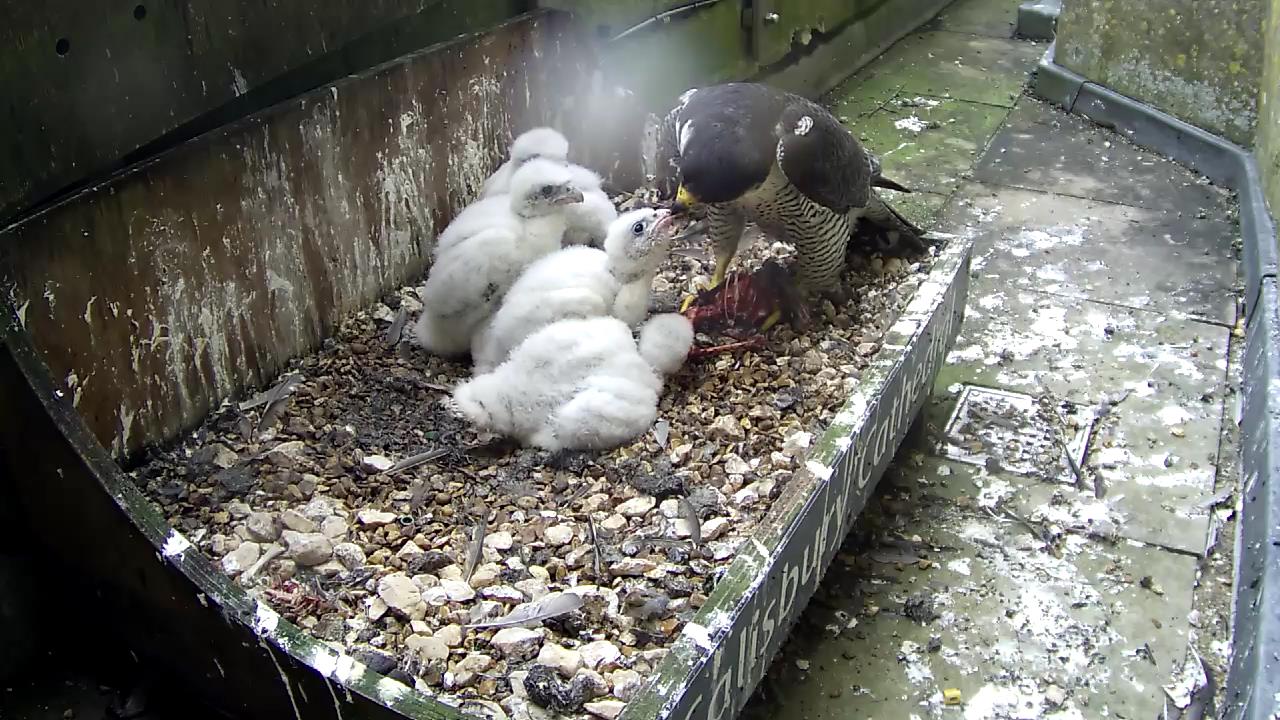Peregrine Blog No 2 2024

In my previous blog dated 28 March 2024, I predicted that with the last of the four eggs being laid on the 28 March, that with an incubation period of typically 32 days, we might expect the eggs to hatch ‘ in the last few days of April’. Our pair have clearly read the text books on Peregrine incubation, as the first egg hatched right on cue on 28 April, with the three subsequent eggs hatching on 29 April, 30 April and 1 May. In past years we have sometimes had the chicks hatch closer together rather than over four days, but hatching over three of four days is fairly typical of the species. On odd occasions elsewhere, often one egg has been ‘written off’ as being infertile, sometimes pushed aside by the other chicks, but hatches unexpectedly several days after the rest of the brood. It is only with the advent of nest cams on mainly urban sites that we have ever become aware of this type of situation.
I was out of the country (on a birdwatching holiday; where else) with no internet access when the eggs hatched and shortly afterwards, so missed the hatching and the first few days of the chicks lives. The weather was wet on occasions but I understand that the tiny chicks were well sheltered beneath the female during the worst of the weather; relatively easy when the chicks are very small. Not so easy when the chicks are larger as seen on the Sunday night and early Monday morning just passed when we had about twelve hours of almost continual rainfall. On the several occasions I logged in during daylight and nighttime hours the female was sheltering the chicks from a mostly standing up position and looking extremely bedraggled in the process. Monday morning dawned dry and bright and happily all of the chicks were looking dry and healthy and have continued to thrive. The adults, mostly the male, has kept up a constant supply of food for the four chicks. I have seen a variety of small unidentifiable birds brought to the nest, together with several Pigeons and what looked like a Jackdaw. I gather from others that what looked like two waterbirds, probably Moorhens, have also been on the menu. In past years, Black Headed Gulls have also been a favoured prey species, but mostly only at the point of fledging and shortly afterwards. This behaviour has been observed at other urban sites; quite why they should be brought in mostly late in the breeding cycle is not known. What we do know about Peregrine behaviour at the nest has come on in leaps and bounds in recent years with the advents of increasingly sophisticated nest cams. Not so long ago it was believed that the female did almost all of the feeding of the chicks. Whilst she still does the majority of the feeding, it has become apparent both at Salisbury and elsewhere that the male does rather more feeding than once thought. A particularly interesting event was recorded on 3 May when the male came to the nest box with a small prey item and fed the female bill to bill in the same way as she feeds the chicks, and whilst she was brooding the chicks; not a behaviour commonly seen I believe. Elsewhere this year, a chick fledged from the previous year has returned to its natal nest site as a one year old and has been recorded helping feed this year’s brood of chicks with no apparent reaction from the resident pair who are likely to be its parents. Our resident pair are clearly very dutiful parents, not seemingly so the pair at our ‘sister’ cathedral at Winchester where the new female this year managed to knock all four eggs out of the nest tray onto the walkway. She attempted to incubate some of the eggs on the walkway which was always likely to fail. The Peregrine team at the cathedral, ever hopeful, put the eggs back on the tray, but the female subsequently ate them and then for a short while incubated an empty scrape. Possibly the new female was an inexperienced first time breeder, hopefully things will be better there next year. What it does show is just how useful these nest cams are at recording such behaviour; in the past we would have had no idea why the nest attempt had failed.
When the chicks are about two weeks old, it is always interesting to speculate as to which are female and which are male. Male chicks are substantially smaller than the females, as of course are the adult males compared with the adult females. At the chick stage, this is not always apparent, especially from the overhead nest cam which shows the chicks in ‘plan form’ so to speak. It seems to be a little easier from the side nest cam when the chicks are standing up in a line to be fed; the females looking rather taller. This year, as in some past years, we do seem to have one noticeably smaller chick, often starting at the back of the ‘food queue’ but always seemingly able to muscle through to the front and get fed as the rest stop begging as they become full. I suspect this is a male, but things are complicated by the fact that the eggs hatched over a period of four days; perhaps this was the last chick hatched and the others had several days ‘head start’ over it as it were. All will be revealed soon when the chicks are ringed and weighed; the relative weights of the chicks should be enough for us to establish the sex of all four chicks.
Granville Pictor 15 May 2024




